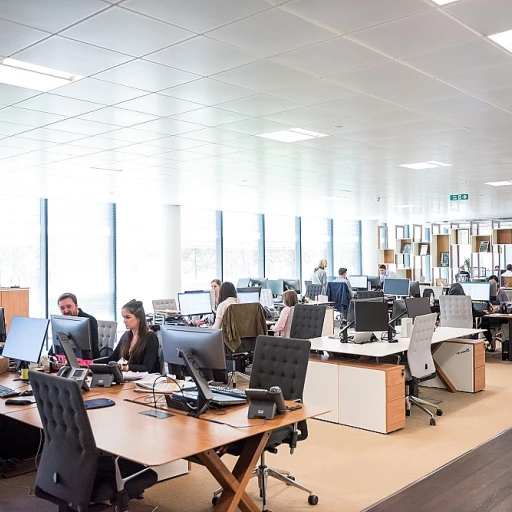
Understanding the Importance of a Secure Office
The Critical Role of Security in Modern Offices
The modern office space is no longer just a place where employees complete their daily tasks. It is a dynamic environment that requires a vigilant focus on security to protect sensitive data, safeguard employees, and maintain the integrity of business operations. Ensuring a secure office not only involves physical protections but also encompasses the digital domain, making comprehensive security measures an essential component of office management.
Businesses, whether large corporations or small businesses, must prioritize office security to provide a safe and secure environment for their employees and visitors. As organizations increasingly adopt remote work and leverage technology, the challenges of securing office spaces extend beyond physical boundaries, impacting corporate networks and data access policies.
One of the foremost concerns is the safety of sensitive data and information systems. Breaches can lead to significant financial losses and irreparable damage to a company's reputation. Implementing a robust privacy policy and employing advanced software solutions are vital steps in safeguarding company assets and ensuring compliance with regulations.
Moreover, establishing a secure conference room for meetings that may involve confidential discussions is crucial. It is equally important to focus on securing access to all areas of the office, from dedicated desks to shared working spaces. The use of security cameras and controlled access systems can further enhance security measures, providing real-time monitoring and preventing unauthorized entry.
Read more about why it’s essential to ensure compliance in all aspects, as highlighted in this comprehensive resource. This attention to detail sets the foundation for a secure workspace where employees can thrive, free from the distractions and risks associated with security breaches and safety issues.
Identifying Common Security Challenges
Recognizing Potential Security Threats in the Workplace
In today's dynamic business environment, ensuring the safety and security of both employees and sensitive data is critical. Businesses and office managers must be proactive in identifying common security challenges that can compromise their office space. By examining these vulnerabilities, companies can implement more comprehensive measures to safeguard their operations. One of the primary concerns is unauthorized access to office space, particularly in open-plan environments or shared workspaces. Security lapses can occur when employees fail to adhere to access policies or when visitors are not properly vetted. Maintaining a secure office requires a focus on all entry points, ensuring that only authorized personnel can enter sensitive areas such as the conference room or server room. Data security is another significant area that requires attention. As businesses increasingly rely on digital resources, the risk of cyber threats grows. Malware, phishing attacks, and unauthorized access to corporate networks can lead to data breaches, endangering sensitive information. To mitigate these risks, a robust data protection strategy, including encryption and secure software, is essential. Additionally, the physical security of the workplace should not be overlooked. Security cameras and alarm systems play a critical role in deterring theft and vandalism. Real-time monitoring and alerts can help office managers promptly respond to incidents, helping keep the environment safe for all employees. Workplace policies should extend to remote workers as well, ensuring that they have access to secure networks and are aware of best practices for safeguarding company data. When employees access corporate resources from different locations, the potential for security risks increases. Clear guidelines and regular training programs can help maintain security. These challenges highlight the need for a comprehensive approach to office security. By identifying potential risks early, businesses can create a secure working environment that protects both employees and vital company assets. For more on ensuring compliance and implementing quality control measures, read our blog on economic assistance programs. By addressing these issues head-on, companies can foster a culture of security awareness and ensure the longevity and success of their operations."Implementing Effective Security Protocols
Implementing Practical Security Strategies
In today's fast-paced business environment, maintaining a secure office is paramount to safeguard sensitive data and ensure the safety of employees. With the rise of remote work and the increasing accessibility of corporate networks, businesses must address potential security risks proactively.
A key aspect of maintaining office security is controlling access. This involves more than just locking doors; it requires a comprehensive strategy. Implementing security cameras in strategic locations can provide real-time monitoring, helping office management identify and respond to potential threats promptly. Moreover, utilizing access cards or biometric systems can restrict entry to sensitive areas, such as private offices or the conference room, ensuring only authorized personnel can enter.
Another crucial component is data protection. Sensitive data must be protected through robust software solutions that encrypt information and prevent unauthorized access. Businesses can leverage advanced security software to monitor and manage access to digital resources effectively.
Furthermore, establishing a culture of security within the workplace begins with clear policies and regular training. Employees must be aware of the critical nature of security protocols and understand their role in keeping the office secure. Regular training sessions and refresher courses can help ensure that security measures are upheld, as well as promote vigilance among employees.
Additionally, businesses should consider implementing a privacy policy that outlines how sensitive information is handled and protected within the office space. This not only assures employees but also builds trust with clients and partners who entrust their data to the company.
For small businesses, implementing these strategies does not have to be expensive. There are cost-effective solutions available that can significantly enhance office security. It's important to perform regular audits and updates to security systems to address any vulnerabilities promptly.
For further insights on maintaining strong communication as part of a security strategy, you may want to explore resources related to enhancing email communication.
Leveraging Technology for Enhanced Security
Elevating Security through Technological Advancements
Technology plays an integral role in enhancing security measures within the office space. Embracing modern advancements not only ensures a safer environment but also instills confidence among employees and visitors alike, fostering a culture of security. To bolster your company's security protocols, consider the following technological implementations:- Security Cameras: Installing cameras strategically throughout the office can provide real-time monitoring and assistance with identifying potential security risks. These devices offer a layer of protection by deterring unauthorized access and capturing evidence in case of any security breach.
- Access Control Systems: Implement access control systems that limit entry to specific areas, such as conference rooms and private offices. By assigning access levels according to the roles and responsibilities of employees, your company can significantly reduce the risk of data breaches and unauthorized entry.
- Data Protection Software: Investing in robust security software can help safeguard sensitive data across the corporate network. Such systems should include features like encryption and secure cloud storage solutions to keep confidential information protected.
- Secure Office Devices: Equip employees with secure devices that protect against malware and unauthorized data access. Educate staff on the importance of following company policies regarding device usage and the handling of sensitive information.
Training and Awareness Programs
Creating Awareness Through Educational Initiatives
In any office space, the foundation of maintaining a secure environment lies not only in installing security cameras or access protocols but also in empowering employees through comprehensive training. Such initiatives should be designed to keep employees informed about the potential security risks present in a corporate network and how to mitigate them. Engage your workforce in interactive training sessions that cover various aspects of office security. These sessions should educate employees on the importance of safeguarding sensitive data and following secure office practices. Hosting regular workshops or seminars can be an effective way to disseminate knowledge, helping to turn potential vulnerabilities into strengths. Implementing a structured training program can include:- Understanding Security Protocols: Educate employees on crucial elements such as password management and recognizing phishing attempts. Reinforce policies about handling private office data and the appropriate use of office software.
- Emergency Response: Conduct drills and simulations to prepare staff to respond swiftly in situations that threaten business security, such as data breaches or unauthorized access to a conference room.
- Remote Work Precautions: As remote workers become a key part of many businesses, address security measures for remote access, ensuring that employees understand how to protect the integrity of the work from anywhere.













